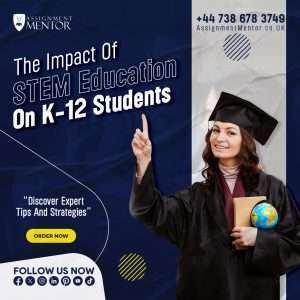However, Science, Technology, Engineering, and Mathematics (STEM) education is now, by all means, a fundamental part of modern teaching practises, particularly in K-12 school education. K‐12 refers to education from kindergarten to 12th grade, which is all of a child’s formal schooling before going to college or university. This part is critical because it constitutes the basic building block in the process of cognitive, social and emotional development. Integration of STEM in K12 curricula develops students to function in today’s world demands and enhances students’ critical and creative thinking abilities.
In this blog, we’ll look at how STEM education affects students in K-12, its advantages, its challenges, and what it means for students’ futures.

1. Teaching Critical Thinking and Problem-Solving Skills
Today, the education of STEM emphasises critical thinking and creative solving problems, these core competencies of professional success in any field. K-12 students learn to solve problems methodically by engaging in hands-on projects such as coding courses uk, designing prototypes, or conducting experiments. As one example, a STEM project might prompt students to create a bridge using only limited materials. They learn by trial and error, they learn to test hypotheses, analyse the results, and refine their solutions. This iterative process is an identity of a professional in a STEM field; students will be prepared to deal with the challenges as well as be resilient and adaptive.
2. Careers for Future Students
During the K – 12 phase, students should explore career fields that are expanding, and STEM education gives them insight into such growing fields. STEM skills are needed to become an artificial intelligence, renewable energy, or data science career. Introducing students to STEM concepts early in K-12 education excites and encourages students to think about these subjects. Imagine a middle school coding class that inspires a student to become a software developer. But by high school, they may be fully equipped with foundational skills to succeed in college STEM programs.
3. Applying Interdisciplinary Learning
In this case, K-12 STEM education breaks out of traditional subject silos and creates integrated science, technology, engineering, and math teaching and learning. For example, in the case of physics, students can design a structure in geometry, and biology, students can create a simulation by using coding skills. An interdisciplinary approach of this nature illuminates students with the connectedness of knowledge and encourages them to think creatively and innovatively. The learning students achieve in such a context prepares them well for tackling complex challenges such as how to combat climate change or solve global health problems which often require knowledge from multiple domains.
4. Causing More Engagement and Motivation
Unlike the traditional rote type of learning, STEM education makes learning fun and relevant to students. Thanks to project based learning books and experiential learning, STEM nurtures curiosity and enthusiasm. As an example, in an engineering class, students may be assigned the design of a simple robotic arm. What makes this activity an especially good activity is that it not only reinforces mechanical principles but also excites a feeling of accomplishment and compels students to investigation onward with STEM.
5. Equity and Inclusion
STEM programs have a key role to play in closing the achievement gap in education. Historically, underrepresented groups, including girls and smaller portion face barricades of entry towards STEM fields. Initiatives to fill this gap include coding camps for girls or robotics clubs in underserved communities. In promoting further diversity in these fields, schools can ease the way for all K-12 students of all backgrounds to which STEM is made accessible. This environment of diversity makes a richer learning environment and a greater inclusive workforce.
6. 21st Century Skills Development
K–12 STEM education offers students’ knowledge that is more than technical knowledge and is crucial to 21st-century skills that include but are not limited to, communication, collaboration, and digital literacy for digital learning solutions. These aren’t just skills for careers in science, technology, engineering, and math (STEM) careers, they’re skills for all careers. If, for instance, we get a bunch of students to do a group project together, students also learn how to be part of a team as well as effective communication. Similarly, it also makes the users more digitally fluent which is very important in a world in which all are powered by technology.
7. Social Implications Beyond Themselves
With this said, however, the good of STEM education in K–12 goes beyond the individual kid. In a workforce that can drive innovation and solve such global challenges, schools help create a STEM-literate generation. For instance, students, in K-12 STEM programs, can be persuaded to develop solutions to sustainable energy problems or discover medical breakthroughs. Along with that, STEM education fosters a culture of curiosity and continuous learning to gear society up in an age of fast technological change.
CONCLUSION
The system transforms K-12 students to better prepare for an innovative and flexible future by giving them STEM education. STEM promotes interdisciplinary learning, a level in critical thinking, and inclusivity, so students are learning with the skills and mindset to be successful in the classroom and in their careers. A STEM-educated generation of K-12 students can be leaders, problem solvers, and innovators in a quickly modernising world. The idea that STEM is preparing our children for the future is a misconception; the truth is that STEM created the future we now have.







